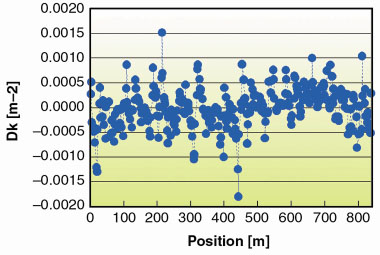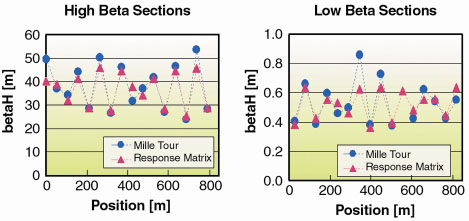- Home
- Users & Science
- Scientific Documentation
- ESRF Highlights
- ESRF Highlights 2001
- The X-ray Source
- Investigating the Lattice Focusing Errors
Investigating the Lattice Focusing Errors
The correction of optics asymmetry due to quadrupole errors is of great importance in reaching the ideal performance of the storage ring. Following the success of utilising the off-diagonal orbit response matrix to deduce skew quadrupole errors for the analysis and correction of coupling, the extraction of normal quadrupole errors has recently been attempted. Errors are deduced by fitting the diagonal response matrix of the model to the measured. The start is from a symmetrical solution and the steerer calibration found in the averaged response matrix analysis. An iterative solution of a linearised equation is made with the singular value decomposition (SVD) method. An application was made to the response matrix measured with all quadrupole correctors switched off. The error distribution obtained (Figure 177) gives a reasonably good fit in both planes.
 |
Fig. 177: Quadrupole error distribution along the ring circumference deduced from the response matrix. |
Twiss parameters and the invariant of motion can be extracted from the phase space constructed at every straight section using the mille-tour beam position monitors (MTBPMs). Beta and phase advances are obtained at each BPM by analysing the spectral amplitude and phase on the tune frequency. The excellent precision of MTBPMs enabled us to detect a quad error of 10-4 in strength deliberately introduced into the lattice. Such an error was detected as a step change in the phase advance. An application was also made to study the origin of betatron tune shift with beam current, by taking the difference in phase advance between 5 and 200 mA. Contrary to the case of the localised error, the result showed a smooth increase in the phase difference, which is consistent with the hypothesis that the origin is the wake field generated in low-gap chambers distributed around the ring.
Figure 178 presents a comparison of the beta functions along the ring circumference by both methods (response matrix and MTBPMs) showing a remarkable agreement. On the basis of the quadrupole error distribution obtained, an online correction of the optical asymmetry is underway. To be able to iterate the correction, a partial response matrix acquisition on a limited number of steerers will be made to speed up the process. The linking of this scheme to the conventional correction of half-integer resonances will also be pursued. As opposed to the classically applied correction of the closest half integer resonance, this method should correct a large number of resonances simultaneously.
 |
Fig. 178: Horizontal beta measured along the ring circumference for an uncorrected lattice. A good agreement is reached between the response matrix and the MTBPMs type of measurement. |



